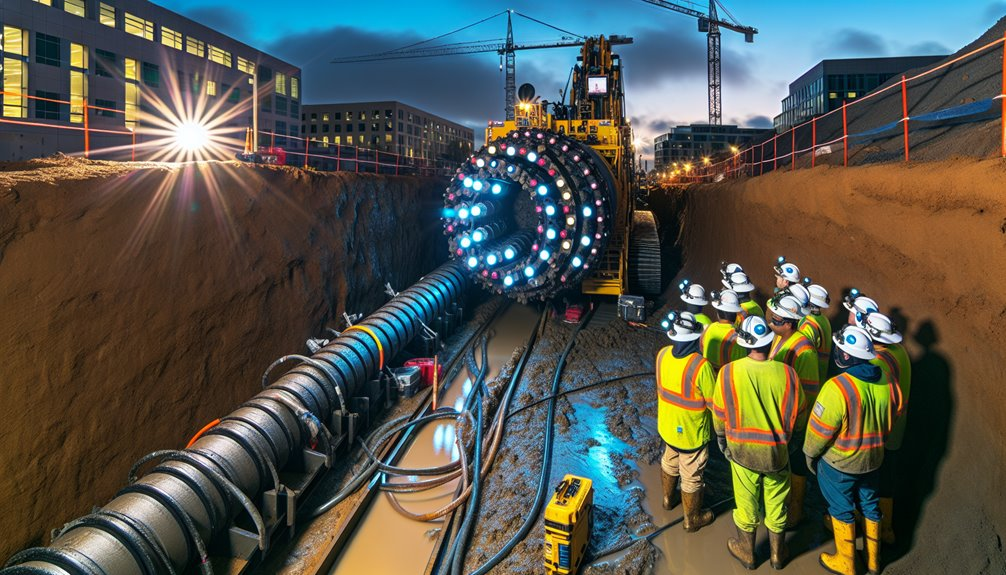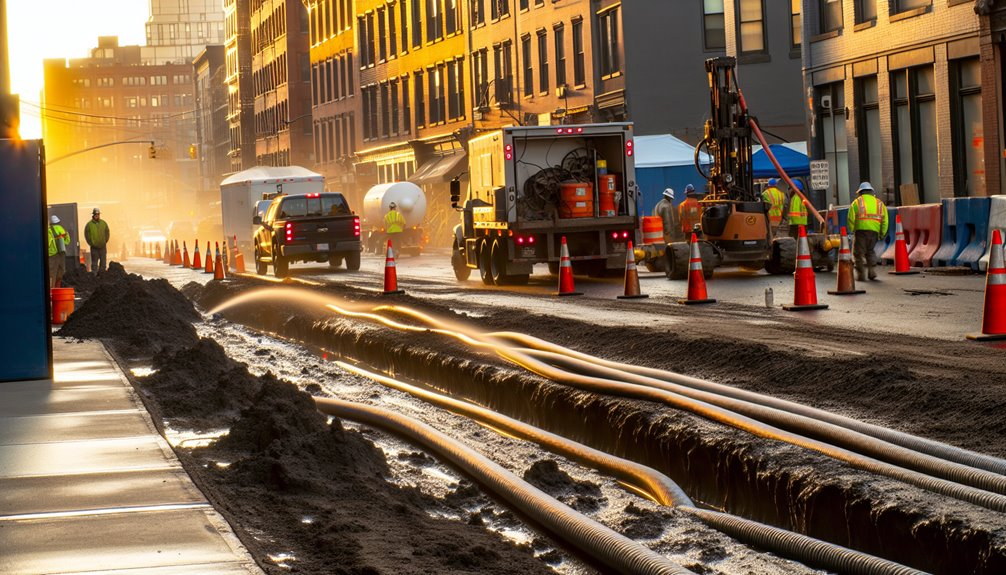You should pick microtunneling when you need tight line-and-grade (±10–20 mm), controlled settlement, and a closed, pressurized face under high groundwater or mixed ground. It’s suited for long gravity pipelines beneath roads, rail, or levees where HDD or auger tolerances, steering, and fluid losses risk noncompliance. With slurry support, real-time instrumentation, and QA per ASTM/EN standards, you’ll trade higher shaft/mobilization costs for predictable schedule and lifecycle performance—if the constraints justify it.
High Groundwater and Pressurized Face Conditions
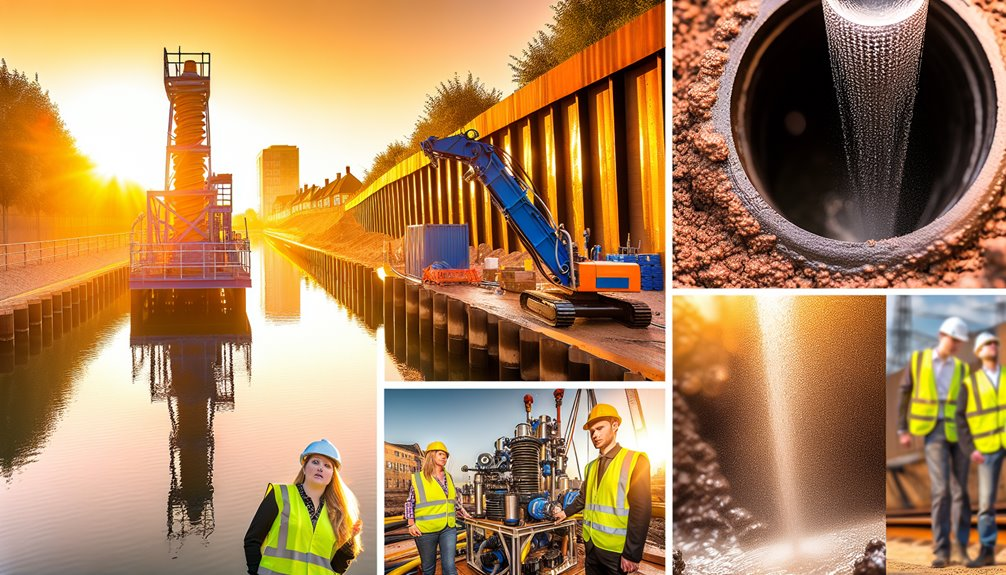
When groundwater levels are high or the face is pressurized, microtunneling’s closed-face, slurry-supported excavation maintains face stability and controls inflow better than open-face trenchless methods.
You manage pore pressures with a pressurized slurry circuit, matched to overburden and hydrostatic head, limiting ground loss and heave.
Specify face stability monitoring with real-time chamber pressure, slurry density, flow, and sand content sensors; set acceptance bands per ITA/AITES and ASCE guidelines.
Pair this with high pressure dewatering only where drawdown won’t trigger settlement or regulatory constraints.
You’ll reduce risk of piping, basal heave, and uncontrolled inflows, particularly in sands, silts, and mixed-face conditions.
Adopt contingency protocols for clogging and gas.
Validate parameters with preconstruction lab testing, site-specific geotechnical baselines, and documented QA records.
Tight Line-and-Grade Tolerances for Gravity Pipelines
Although multiple trenchless options can place pipe accurately, you choose microtunneling for gravity sewers requiring tight line-and-grade tolerances (typically ±10–20 mm and ±0.05–0.10% grade over hundreds of meters) because guidance is continuous and closed-face stability limits ground loss that drives deviation.
You’ll hold the designed slope so flows stay self-cleansing and manhole benches align. Laser or gyro guidance tied to jacking frame survey control delivers invert accuracy that meets EN 16191, ASCE 36-15, and typical utility owner requirements. You also reduce ovality and joint offsets that compromise inspection access and CCTV verification.
Specify pipe stiffness, jacking load capacity, and real-time annulus lubrication to control drag and deflection. Require documented as-builts, station-by-station line/grade reports, and tolerance conformance criteria so your team can certify acceptance without dispute.
Dense Urban Corridors With Settlement Sensitivity
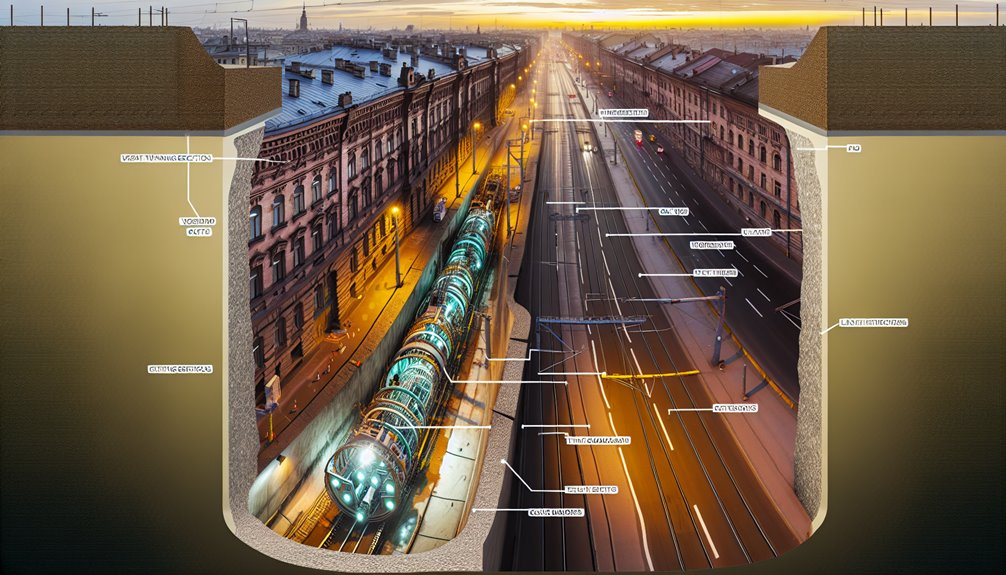
Because surface assets and third-party utilities can’t tolerate even millimeters of heave or loss, you choose microtunneling in dense corridors to minimize settlement risk through closed-face pressure balance and controllable annular overcut.
You maintain face support within ±5 kPa of anticipated earth and groundwater pressures, then grout the annulus with low-shrink mixes meeting ASTM C941 yield tests.
You specify jacking forces per EN 1610 and monitor lubrication to keep overcut voids stable.
You deploy vibration monitoring at critical receptors, setting PPV thresholds ≤2 mm/s to protect masonry and heritage facades.
You document precondition surveys and property compaction baselines, then implement real-time settlement arrays with sub-millimeter accuracy.
With closed-loop control and verifiable records, your corridor stays open, utilities stay safe, and stakeholders stay aligned.
Mixed Grounds, Cobbles, and Boulders Requiring Slurry Support
Settlement control isn’t the only driver for microtunneling—you also need it where mixed-face strata, gravels, cobbles, and boulders demand stable slurry support and precise pressure management.
You benefit from closed-face MTBM systems that maintain face pressure within ±0.05 bar of overburden to prevent inflow and loss of ground.
Specify slurry stabilization with engineered bentonite/polymer blends to control viscosity (35–60 s Marsh funnel) and density (1.05–1.20 g/cm³).
Use crushers and desanders sized for D95 up to 150 mm to manage cobble segregation and minimize cutterhead stalls.
Instrumentation—pressure cells, torque/RPM trending, and flow meters—lets you validate conformance with EN 12889 and ASTM F1962 guidance.
When you need repeatable control across heterogeneity, microtunneling’s slurry circuit, real-time telemetry, and face conditioning deliver predictable advance rates and bore stability.
Long Drives and Curvature Control With Remote Guidance
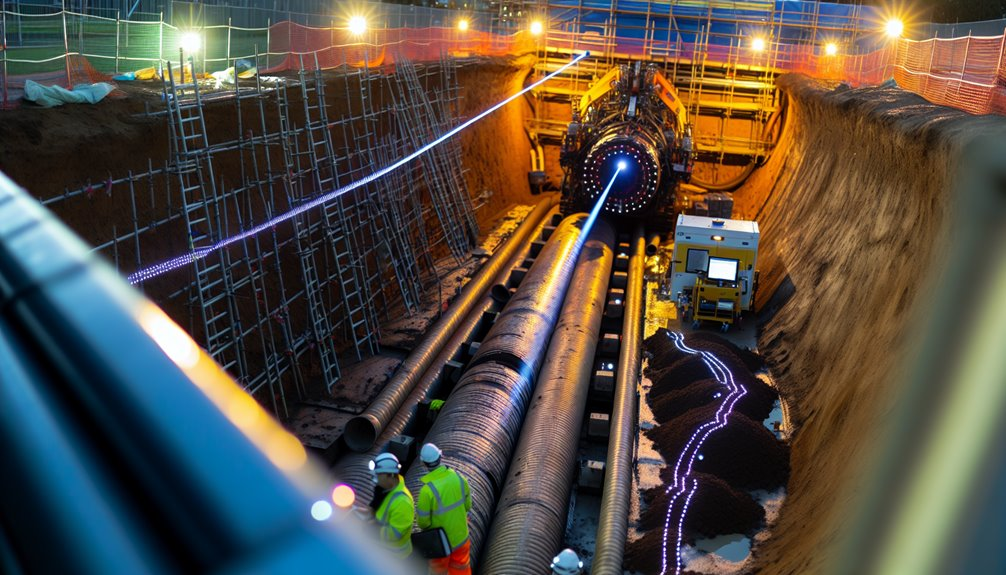
When you push beyond 300–600 m per drive, microtunneling’s remote guidance, articulated TBM joints, and continuous slurry support maintain line and grade within ±10–20 mm and curvature within design Rmin.
You’ll hold that tolerance by integrating remote instrumentation—laser gyros, TSS, and downhole pressure cells—with closed-loop steering algorithms that convert deviation vectors into cylinder thrust commands.
You’ll validate performance against EN 12110 and ASTM F1962 planning criteria, tracking cumulative jacking loads and ring geometry to control thrust eccentricity and roll.
With segment pitch control and real-time annulus pressure management, you minimize overcut and manage bend changes, keeping the drive within allowable chord offsets.
Your team reads the same dashboards, acts on the same thresholds, and delivers predictable long-drive geometry without rework.
Crossing Critical Infrastructure and Restricted Rights-of-Way
Long-drive accuracy isn’t just for distance; it underpins risk control beneath rail corridors, utility bundles, levees, and airfields where clearance envelopes are tight and access is constrained.
You pick microtunneling when you must hold line and grade within millimeters, document face pressure, and maintain full ground support.
With sealed slurry circuits and segmental jacking, you protect adjacent assets while meeting rights of way stipulations and emergency access requirements.
You’ll align utility coordination early, verifying clearances with as-built scans and PAS 128/QS-accurate records.
Microtunneling’s closed face and continuous monitoring satisfy regulatory compliance under AREMA, FAA, and USACE criteria, reducing settlement envelopes to near-zero.
You also minimize shaft footprints, optimize shift windows, and maintain service continuity across critical crossings without reactive interventions.
Environmental and Community Constraints on Noise and Vibration

Although all trenchless methods reduce surface disruption, microtunneling further limits community impacts by controlling acoustic and vibratory emissions at their sources and interfaces.
You operate within ANSI/ASA S12.9 Part 4 and ISO 2631 frameworks, so you’ll value predictable, low noise and minimal vibration signatures.
Closed-face MTBM cutters, pressurized slurry circuits, and variable-frequency drives keep sound power levels and particle velocities below neighborhood thresholds.
You can stage power packs in acoustic enclosures, apply compliant mufflers, and use elastomeric mounts to attenuate ground-borne vibration near hospitals, labs, and historic foundations.
Verify compliance with municipal nighttime dBA caps and PPV limits (for example, 0.12–0.3 in/s for fragile structures).
Instrumentation—Class 1 sound level meters and tri-axial geophones—lets you trend exceedances, adapt advance rates, and maintain trust.
Cost, Schedule, and Risk Tradeoffs Compared to HDD, Auger Boring, and Pipe Bursting
Because capital and risk profiles drive trenchless selection, you should quantify microtunneling’s higher upfront costs against its tighter control of line/grade, face pressure, and settlement relative to HDD, auger boring, and pipe bursting. You’ll typically see premium bid prices, but you reduce variance in outcomes.
HDD can lower initial spend and shorten mobilization, yet carries higher risks for hydrofracture, bore deviation, and fluid loss; you’ll budget larger contingency planning allowances.
Auger boring suits short, stable runs; however, limited steering and face support raise change-order exposure.
Pipe bursting offers speed in replace-in-place scenarios, but utility strikes and heave risks require conservative staging.
When you monetize schedule certainty, avoided claims, and compliance with tolerances, microtunneling’s life cycle costs often normalize. Apply AACE and ISO 31000 frameworks to compare risk-adjusted NPV and float consumption.
Conclusion
When I weigh the options for a tricky underground install, I pick microtunneling when we need ±10–20 mm line-and-grade, sub‑millimeter settlement control, and closed-face slurry support under high groundwater. It’s a go-to for long gravity sewers beneath roads, rail, levees, and tight ROWs because remote guidance, curvature control, and continuous real-time instrumentation let us minimize noise, vibration, and surface disruption while meeting utility and environmental constraints. Yes, shaft and mobilization costs can be higher, but with rigorous QA/QC and adherence to standards like ASTM, ITA, and ISO we reduce owner risk and keep schedules predictable. If you’d like to talk through whether microtunneling is right for your project, visit boringbro.com or give us a call at (954) 639-6167 — I’d love to help.

